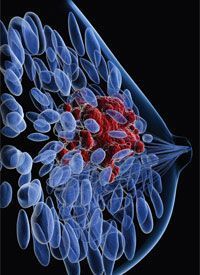Article
NICE Recommends Neoadjuvant Pembrolizumab/Chemotherapy, Followed by Adjuvant Pembrolizumab for TNBC
Author(s):
The National Institute for Health and Care Excellence has issued final guidance supporting use of neoadjuvant pembrolizumab in combination with chemotherapy, followed by adjuvant pembrolizumab, for adults with triple-negative breast cancer.
Triple-Negative Breast Cancer

The National Institute for Health and Care Excellence (NICE) has issued final guidance supporting use of neoadjuvant pembrolizumab (Keytruda) in combination with chemotherapy, followed by adjuvant pembrolizumab, for adults with triple-negative breast cancer (TNBC) who are at high risk for recurrence or who have locally advanced breast cancer.1
NICE estimates that there approximately 3200 patients in the United Kingdom with TNBC. Of those, approximately 1600 will be eligible for treatment with pembrolizumab. NICE expects to publish final guidance on pembrolizumab for treating early or locally advanced TNBC early in December 2022.
“TNBC has a relatively poor prognosis and there are few effective treatments compared with other types of the disease,” Helen Knight, interim director of medicines evaluation at NICE, said in a news release. “Today’s draft guidance means that we have now recommended 3 new treatments for routine use in the NHS since June, helping to address this unmet need and giving hope of a longer and a better quality of life to thousands of people.”
In July 2022, NICE recommended sacituzumab govitecan-hziy (Trodelvy) for TNBC and alpelisib (Piqray) for patients with advanced breast cancer. Alpelisib is the first targeted treatment recommended for certain patients with a PIK3CA mutation.2
In the phase 3 KEYNOTE-522 trial (NCT03036488), investigators followed 1174 patients with TNBC treated with neoadjuvant chemotherapy plus pembrolizumab (n = 784) vs those who were treated with neoadjuvant chemotherapy plus placebo (n = 390). At a median follow-up of 39 months, neoadjuvant pembrolizumab plus chemotherapy, followed by adjuvant pembrolizumab resulted in a 37% reduction in the risk of events or death compared with neoadjuvant chemotherapy followed by adjuvant placebo (HR, 0.63; 95% CI, 0.48-0.82; P < .001).3
The estimated 36-month event-free survival (EFS) rate was 84.5% (95% CI, 81.7%-86.9%) in the investigative arm vs 76.8% (95% CI, 72.2%-80.7%) in the control arm. The median EFS was not yet reached in either arm.
Overall survival (OS) data were immature; however, 10.2% of patients in the investigative arm and 14.1% of those on the control arm died (HR, 0.72; 95% CI, 0.51-1.02). The estimated 36-months OS rate was 89.7% (95% CI, 87.3%-91.7%) in the pembrolizumab/chemotherapy arm vs 86.9% (95% CI, 83.0%-89.9%) in the placebo/chemotherapy arm. The median OS had not yet been reached in either treatment arm.
NICE noted that pembrolizumab was not associated with a statistically significant difference in OS but pointed to the statistically significant difference in EFS in recommending the agent. Clinical experts noted that the benefits seen for pCR and EFS suggested that pembrolizumab will confer an OS benefit with more follow-up.
In May 2022, NICE issued final guidance recommending approval of pembrolizumab plus with paclitaxel or nab-paclitaxel (Abraxane) for the treatment of patients with PD-L1–positive metastatic TNBC who have not received chemotherapy in the metastatic setting and who are not eligible for surgery. The recommendation is for patients with TNBC with a PD-L1 at combined positive score (CPS) of 10 or above and an immune cell staining less than 1%.4
Investigators evaluated pembrolizumab in combination with investigator's choice of either nab-paclitaxel, paclitaxel, or gemcitabine/carboplatin, vs placebo plus 1 of the 3 chemotherapy agents in patients with previously untreated locally recurrent inoperable or metastatic TNBC (N = 847) in the 2-part, phase 3 KEYNOTE-355 trial (NCT02819518). In final data presented at the 2021 ESMO Congress, the median OS among patients with a PD-L1 CPS of at least 10 was 23.0% in the experimental arm vs 16.1% in the control arm (HR, 0.73; 95% CI, 0.55-0.95; P = .0093). The median PFS was 9.7 vs 5.6 months, respectively, (HR, 0.66; 95% CI, 0.50-0.88).5
References
- NICE final draft guidance adds further treatment option for triple-negative breast cancer. News release. November 8, 2022. Accessed November 8, 2022. https://bit.ly/3EcnP1Y
- Wise J. NICE approves two more treatment options for advanced breast cancer. BMJ. 2022 Jul 14;378:o1751. doi:10.1136/bmj.o1751
- Schmid P, Cortes J, Dent R, et al. Event-free survival with pembrolizumab in early triple-negative breast cancer. N Engl J Med. 2022;386(6):556-567. doi:10.1056/NEJMoa2112651
- New injectable immunotherapy treatment for rare form of triple negative breast cancer recommended by NICE. News release. May 25, 2022. Accessed November 8, 2022. https://bit.ly/3abUoAs
- Rugo HS, Cortes J, Cescon DW, et al: KEYNOTE-355: Final results from a randomized, double-blind phase III study of first-line pembrolizumab + chemotherapy vs placebo + chemotherapy for metastatic triple-negative breast cancer. Ann Oncol. 2021;32(suppl 5): S1283-S1346. doi:10.1016/annonc/annonc741









